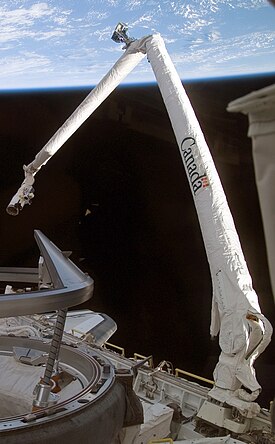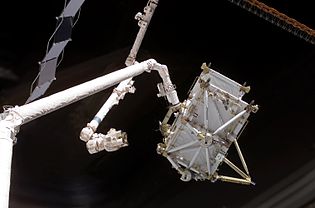For the robotic arm on the International Space Station, see Canadarm2.
| This article needs additional citations for verification. (February 2009) |
View of the Canadarm during Space Shuttle mission STS-116.
The Shuttle Remote Manipulator System (SRMS), also known as the Canadarm (Canadarm 1), is a mechanical arm that was used on the Space Shuttle orbiters to maneuver a payload from the payload bay of the orbiter to its deployment position and then release it. After the destruction of Space Shuttle Columbia during STS-107, NASA began to always pair the Canadarm with the Orbiter Boom Sensor System (OBSS), a boom containing instruments to inspect the exterior of the shuttle for damage to the thermal protection system.
Specifications
The Canadian government wordmark featured on the side of the Canadarm.
The Canadarm is 15.2 m (50 ft) long, and 38 cm (15 in) diameter with six degrees of freedom. It weighs 410 kg (900 lb) by itself, and 450 kg (990 lb) as part of the total system. The Canadarm has six joints that correspond roughly to the joints of the human arm, with shoulder yaw and pitch joints; an elbow pitch joint; and wrist pitch, yaw, and roll joints. The end effector is the unit at the end of the wrist that actually grabs, or grapples, the payload. The two lightweight boom segments are called the upper and lower arms. The upper boom connects the shoulder and elbow joints, and the lower boom connects the elbow and wrist joints. The Canadarm attaches to robots that are controlled from the flight deck.
Capabilities
F. Story Musgrave, anchored on the end of the Canadarm, prepares to be elevated to the top of the Hubble Space Telescope during STS-61.
The original Canadarm was capable of deploying or retrieving payloads weighing up to 332.5 kg (733 lb) in space. In the mid 1990s the arm control system was redesigned to increase the payload capability up to 3,293 kg (7,260 lb) in order to support space station assembly operations. Although the Canadarm can maneuver massive payloads in space, the arm motors are unable to lift the arm's own weight when on the ground. NASA therefore developed a model of the arm for use at its training facility within the Johnson Space Center located in Houston, Texas. The Canadarm can also retrieve, repair and deploy satellites; provide a mobile extension ladder for extravehicular activity crew members for work stations or foot restraints; and be used as an inspection aid to allow the flight crew members to view the orbiter's or payload's surfaces through a television camera on the Canadarm.
The basic Canadarm configuration consists of a manipulator arm; a Canadarm display and control panel, including rotational and translational hand controllers at the orbiter aft flight deck flight crew station; and a manipulator controller interface unit that interfaces with the orbiter computer. Most of the time, the arm operators see what they are doing by looking at the Advanced Space Vision System screen next to the controllers.
One crew member operates the Canadarm from the aft flight deck control station, and a second crew member usually assists with television camera operations. This allows the Canadarm operator to view Canadarm operations through the aft flight deck payload and overhead windows and through the closed-circuit television monitors at the aft flight deck station.
The Canadarm is outfitted with an explosive-based mechanism to allow the arm to be jettisoned. This safety system allows the Orbiter's payload bay doors to be closed in the event that the arm fails in an extended position and is not able to be retracted.
Development
SPAR Aerospace Ltd., a Canadian company, designed, developed, tested and built the Canadarm. Three systems were constructed within the Design, Development, Test and Evaluation contract: an Engineering Model to assist in the design and testing of the Canadarm, a Qualification Model that was subjected to environmental testing to "qualify" the design for flight and a Flight Unit. The main controls algorithms were developed by SPAR and by subcontractor Dynacon Inc. of Toronto. CAE Electronics Ltd. in Montreal provided the display and control panel and the hand controllers located in the Shuttle aft flight deck. Other electronic interfaces, servoamplifiers and power conditioners located on the Canadarm were designed and built by SPAR at its Montreal factory. The graphite composite boom that provides the structural connection between the shoulder and the elbow joint and the similar boom that connects the elbow to the wrist were produced by General Dynamics in the United States. Dilworth, Secord, Meagher and Associates, Ltd. in Toronto was contracted to produce the Engineering model end effector then SPAR evolved the design and produced the Qualification and Flight units. The Shuttle flight software that monitors and controls the Canadarm was developed in Houston, Texas, by the Federal Systems Division of IBM. Rockwell International's Space Transportation Systems Division designed, developed, tested and built the systems used to attach the Canadarm to the payload bay of the orbiter.
In all, five arms (arm 201, 202, 301, 302, and 303) were built and delivered to NASA. Arm 302 was lost in the Challenger accident.
Usage
The Canadarm2 moves toward a P5 truss section, being held by Discovery's Canadarm, in preparation for a hand-off during STS-116
A simulated Canadarm installed on the Space Shuttle Enterprise was seen when the prototype orbiter's payload bay doors were open to test hangar facilities early in the shuttle program. The Canadarm was first used on STS-2 in 1981, on board Columbia, and has subsequently been used on over 50 shuttle missions. Arms have been installed on the four other shuttles - it was first flown on board Challenger during STS-7 in 1983, and then in 1984 on Discovery during STS-41-D, which was Discovery's first flight. It was used on Atlantis first during STS-61-B. Canadarm 302 was lost during the Challenger disaster in 1986. A Canadarm was next used on Endeavour during STS-49, that vessel's first flight.
Since the installation of the Canadarm2 on the International Space Station, the two arms have been used to hand over segments of the station for assembly from the Canadarm to the Canadarm2; the use of both elements in tandem has earned the nickname of 'Canadian Handshake' in the media.
Retirement
The Canadarm's 90th and final shuttle mission was in July 2011 on STS-135. The Discovery and Atlantis Canadarm and OBSS will be left on the shuttles for their museum display. Endeavour left its OBSS at the International Space Station as part of its final mission, while its Canadarm was originally going to be displayed in the headquarters of the Canadian Space Agency. However, Endeavour's Canadarm is now on permanent display at the Canada Aviation and Space Museum in Ottawa.
In popular media
In the movie Iron Sky, a Royal Canadian Air Force version of the Canadarm, named Canadarm 3, is an armed spacecraft that fights against the Nazis during the battle for the earth.
On November 13, 2012, Google Canada displayed a doodle on its home search page to celebrate the 31st anniversary of the Canadarm's first use in space.
See also
| Robotics portal |
- MacDonald Dettwiler and Associates (MDA), the makers of Canadarm
- Space Shuttle program
- Mobile Servicing System (MSS), also known by its primary component the Canadarm2, used on the ISS
- European Robotic Arm, a second robotic arm to be installed on the ISS built in the Netherlands by EADS
- The Remote Manipulator System, used on the ISS module Kibo is a Japanese built robotic arm system
- Dextre, also known as the Special Purpose Dexterous Manipulator (SPDM), used on the ISS and built by MDA
- Strela, a Russian built crane used on the ISS to perform similar tasks as the Mobile Servicing System







0 comments:
Post a Comment